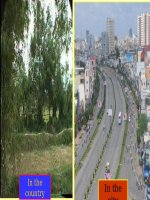1323Chapter 8 minerals and water
Bạn đang xem bản rút gọn của tài liệu. Xem và tải ngay bản đầy đủ của tài liệu tại đây (3.91 MB, 71 trang )
Chapter 8
Minerals and Water
© 2012 Pearson Education, Inc.
Why Is Water So Important?
Water is the most abundant substance in body.
Average healthy adult is about 60 percent water
Muscle: 65 percent water, fat: 10 to 40 percent
water
Age and body composition influence the % of
water in the body
We can only survive a few days without water
Nutrition and You, 2e
© 2012 Pearson Education, Inc.
Your Body is Mostly Water
Figure 8.1
Nutrition and You, 2e
© 2012 Pearson Education, Inc.
Body Water Balance
Water is balanced among fluid compartments
Intracellular fluids: inside cells (60-75% of body
water)
Extracellular fluids: interstitial fluid between
cells and fluid in the blood (25-40% of body water)
Electrolytes: minerals that help maintain fluid
balance
Nutrition and You, 2e
© 2012 Pearson Education, Inc.
Water as Part of Body Fluids
Figure 8.2
Nutrition and You, 2e
© 2012 Pearson Education, Inc.
Functions of Body Water
Acts as universal solvent and a transport medium
Medium for many chemical reactions in body
As part of blood, helps transport oxygen, nutrients,
hormones to cells
As part of interstitial fluid (between cells), helps
transport waste products away from cells for
excretion
Helps maintain body temperature
Is a lubricant for joints, eyes, and is part of mucus and
saliva
Is a protective cushion for brain, organs, fetus
Nutrition and You, 2e
© 2012 Pearson Education, Inc.
Water Helps Regulate Your Body
Temperature
Figure 8.3
Nutrition and You, 2e
© 2012 Pearson Education, Inc.
Maintaining Water Balance
Water balance: water consumed = water lost
We take in water through beverages and food
We lose water through the kidneys (as urine), large
intestine, lungs, and skin (as sweat)
Insensible water loss: through evaporation from
skin and when we exhale
Nutrition and You, 2e
© 2012 Pearson Education, Inc.
The Concept of Water Balance:
Intake Equals Output
Figure 8.4
Nutrition and You, 2e
© 2012 Pearson Education, Inc.
Water Content of Foods
Figure 8.7
Nutrition and You, 2e
© 2012 Pearson Education, Inc.
How Much Water Do You Need and
What Are the Best Sources?
Daily water needs vary depending on physical activity,
environmental factors, and diet.
Adequate Intake for water is based on reported total water
intake of healthy Americans
Men: 16 cups/day (about 13 cups of beverages)
Women: 12 cups/day (about 9 cups of beverages)
Approximately 2 ½ to 3 ½ liters of fluid per day
Nutrition and You, 2e
© 2012 Pearson Education, Inc.
The Best Way to Meet Your Daily Water
Needs
Figure 8.8
Nutrition and You, 2e
© 2012 Pearson Education, Inc.
Think Before You Drink: Can Water
Boost Your Brain?
Nutrition and You, 2e
© 2012 Pearson Education, Inc.
Benefits of An Adequate Water Intake
Decreased risk of
Kidney stone formation
Bladder cancer
Colon cancer
Breast cancer?
Nutrition and You, 2e
© 2012 Pearson Education, Inc.
Signs of Adequate Water Intake
Mouth is moist
Urine is a pale yellow color
Nutrition and You, 2e
© 2012 Pearson Education, Inc.
Urine Color Can Signal Dehydration
Figure 8.6
Nutrition and You, 2e
© 2012 Pearson Education, Inc.
Dehydration
Can result from inadequate water intake or too much
water loss
The thirst mechanism signals dehydration.
Dry mouth due to increased electrolyte concentration
in blood: less water available to make saliva
Blood volume decreases, sodium concentration
increases in blood
Brain triggers thirst mechanism and secretion of
antidiuretic hormone (ADH) to reduce urine output
Fluid inside cells moves into blood by osmosis
Nutrition and You, 2e
© 2012 Pearson Education, Inc.
Who Is Most at Risk for Dehydration?
Anyone suffering from excessive vomiting and diarrhea,
or excessive perspiration
Very young infants and children
The elderly
Active people in very warm climates
Nutrition and You, 2e
© 2012 Pearson Education, Inc.
Water Intoxication
For healthy individuals it is difficult to consume too much
water
Must drink a large amount of water in a short period of
time
Athletes
Hazing
Contest
Causes hyponatremia a condition of too little sodium in
the blood; organs swell causing fatigue, confusion,
disorientation, death
Nutrition and You, 2e
© 2012 Pearson Education, Inc.
Bottled Water
| Bottled Water
Nutrition and You, 2e
© 2012 Pearson Education, Inc.
What are minerals?
Inorganic elements
Needed in the diet in small amounts (milligrams and
micrograms
Needed for life functions
Nutrition and You, 2e
© 2012 Pearson Education, Inc.
Factors Affecting Mineral Bioavailabilty
Composition of the diet
Lactose enhances calcium absorption
Phytic acid, oxalic acid, tannins interfere with
absorption of iron, calcium, sometimes magnesium
and zinc
Form the mineral comes in
Heme versus non-heme iron
Competition with other minerals
Excess zinc can interfere with copper absorption
Body’s need for the mineral
Nutrition and You, 2e
© 2012 Pearson Education, Inc.
Classification of Minerals
Major minerals (macrominerals): needed in amounts
>100 µg/day
Trace minerals (microminerals): needed in amounts
<20 µg/day
Major minerals are needed in larger amounts
Sodium, chloride, potassium, magnesium, sulfur play
key roles in fluid balance.
Calcium, phosphorus, magnesium work together to
strengthen bones and teeth.
Nutrition and You, 2e
© 2012 Pearson Education, Inc.
Classification of Minerals
Trace minerals (microminerals) are needed in small
amounts: <20 µg/day
Present even in smaller amounts in body
Play several essential roles
Chromium and iodine help certain hormones
Iron maintains healthy red blood cells
Fluoride protects teeth
Several trace minerals act as cofactors
Nutrition and You, 2e
© 2012 Pearson Education, Inc.
The Minerals in Your Body
Figure 8.9
Nutrition and You, 2e
© 2012 Pearson Education, Inc.









